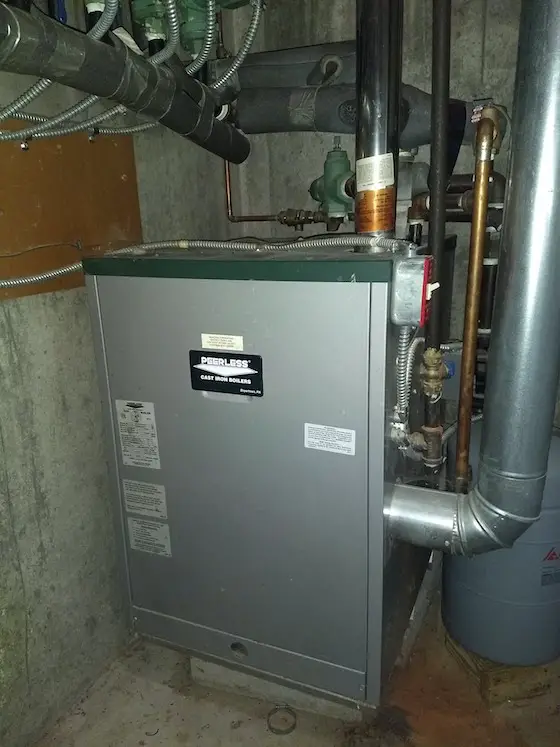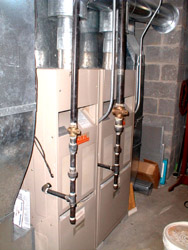Payback Periods

Your insulation payback time depends on how much fuel your boiler or furnace burns each day. This is my own boiler. If the outdoor temperature drops below 5 F, the house loses more heat each hour than the boiler is able to produce in an hour. The colder it gets outdoors the colder it starts to get indoors. Copyright 2018 Tim Carter
"You don't start to save money on any energy-saving improvement until such time as you've paid yourself back in energy savings all of the money, plus interest, that you spent on the energy-saving upgrade."
DEAR TIM: My most recent utility bill took my breath away. It was sky high. I've read different articles in newspapers and magazines that say I can save hundreds of dollars a year on my heating bills.
Is this really possible? If so, it might make sense to replace my 14-year-old 80-percent efficient furnace. What's the best way to calculate the actual savings so I can choose wisely? Connie D., Oshkosh, WI
DEAR CONNIE: I've read similar articles and often wonder if the author was paying attention during math class. Hundreds of dollars to me usually means an amount in the range of $400 - $700.00.
I imagine it is possible for a person to save hundreds of dollars, but these people either live in very large homes, and/or keep their thermostats on high, and/or have little insulation, and/or they have an ancient low-efficiency furnace. Most of us regular folks will save far less than that on an annual basis.
Free & Fast Bids
CLICK HERE to get FREE & FAST BIDS from local furnace, AC and boiler contractors.
CLICK HERE to get FREE & FAST BIDS from local insulation upgrade contractors.
How Do You Calculate Insulation Payback Time?

Here are my two furnaces. They were installed in December, 1986. As of June, 2004, they were still working perfectly. But they are just about at the end of their useful lives. Within 12 months, I will probably replace them with the highest efficiency units I can get.
There are many variables that go into calculating exactly how much money you can save by switching to a high-efficiency furnace and/or adding more insulation. Here are several:
- heating and cooling degree days
- cost of fuel
- amount of solar gain
- maintaining consistent indoor temperature year to year
Heating and cooling degree days each season have a huge impact on payback times. To calculate an accurate payback time you have to make sure you're factoring in the number of heating and cooling degree days from year to year.
Gas fuel rates fluctuate. This year, for example, they are very high as I write this column. When Old Man Winter takes an occasional break and we have mild winters, gas rates can go down as the demand for the fuel lessens.
The economic law of supply and demand determines the price. If you or a salesperson calculates energy savings using your latest fuel bill and the rates go down, your payback period will be wrong! It will take longer to receive a return on your investment as the price of fuel drops.
When Do You Really Start To Save Money By Adding Insulation?
You don't start to save money on any energy-saving improvement until such time as you've paid yourself back in energy savings all of the money, plus interest, that you spent on the energy-saving upgrade.
In other words, if you added more insulation and you wrote a check for $2,500 to do the work, you need to pay yourself back the $2,500 before you start to save money. Don't forget to add in any interest if you finance the improvement. If you took the money from a savings account, you need to also add in the lost interest on your savings.
CLICK HERE to get FREE & FAST BIDS from local furnace, AC and boiler contractors.
CLICK HERE to get FREE & FAST BIDS from local insulation upgrade contractors.
What About the Different Furnace Efficiency Ratings?
The spread between the efficiency of your existing furnace and a new ultra high-efficiency furnace makes a big difference in your calculations. If you get a new 95-percent-efficient furnace, 15 cents more of every dollar you spend on fuel will stay inside your home instead of going up the chimney.
People who have very old furnaces or boilers can save more. But keep in mind that the average useful life of a furnace is just about 20 years. Many furnaces that are 20 years old or younger operate at efficiencies at or above 70 percent efficiency.
How Do I Calculate Energy Savings?
There is a quick and fairly accurate way for you to see how much money you might save each year on your heating bills. All you need to do is have the past 12 months utility bills at hand.
A similar method can be used for people in the south or southwest who want to see how much they spend on air conditioning. Instead of looking at the gas portion of their bill, they would look at the electric portion.
If you heat with natural gas like I do, write down the amount you spend on gas next to each month. Note how little you spend in June, July and August when you do not have the furnace on.
You must determine an average gas cost for these three months. This is the approximate gas cost that you spend on a monthly basis year-round to heat water, dry clothes and cook. People in the south and southwest performing an air conditioning study would look at the winter bills since the air conditioner is turned off at this time.
Study the other nine months. Subtract the average gas cost from the summer months from each bill. You can now see what you spend each month for the gas used to heat your home. Obviously, you spend a larger amount in the dead of winter than you do in October or April.
Should you buy a 95-percent-efficient furnace the net gain is just 15 percentage points. This means that you will save 15 cents of each heating dollar you currently spend to heat your home. Add up your heating costs for the nine months multiply it by 0.15 to see how much your annual savings would have been had you been using the more efficient furnace.
My Own True Energy Savings
I did the calculation for my own home and determined that I would have only saved $179.00 last year. My house is above average in size based on most of the houses I have built and seen in my town.
This tells me that most people might actually save less than $179.00 per year if they have an 80 percent efficient furnace like you and I have.
CLICK HERE to get FREE & FAST BIDS from local furnace, AC and boiler contractors.
CLICK HERE to get FREE & FAST BIDS from local insulation upgrade contractors.
Column 346
One Response to Payback Periods